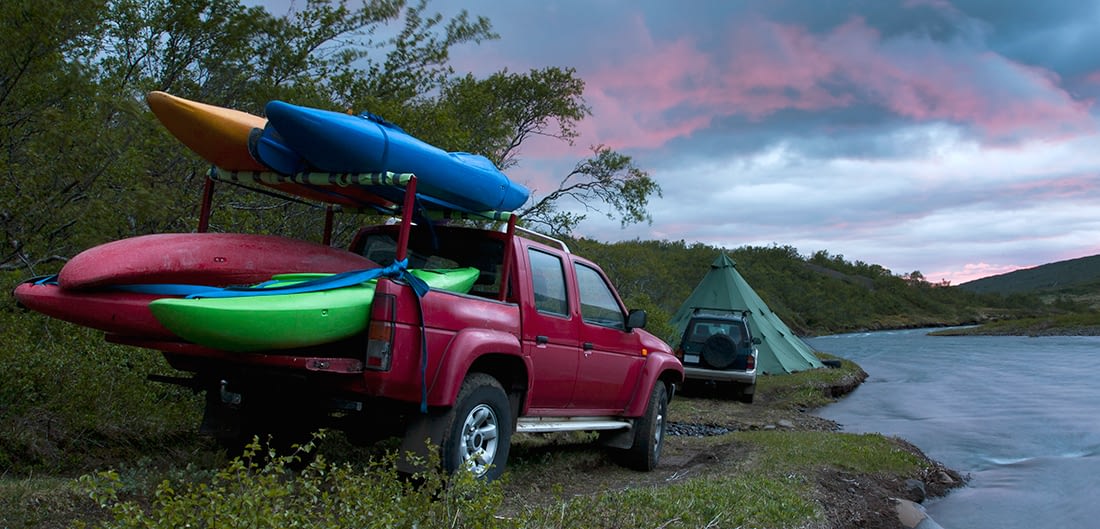
Whether it’s camping, biking, kayaking or skiing, there’s nothing quite like spending time outdoors. Getting outside can be a great way to disconnect from the stresses of everyday life, allowing you to clear your head while enjoying the added benefits of sunshine, fresh air and exercise.
But as the seasons begin to change, so do the outdoor recreation activities you’re able to enjoy. And this fact inevitably leads us to the hassle of storing all that gear for the offseason.
After all, you won’t need to keep your sleds, snowshoes or snowboard on hand once April and May arrive. And you probably won’t be needing your tent, fishing gear, golf clubs or lawn games when the snow starts to fall.
Learn more: How homeowners insurance can protect your important gear
Initially, the thought of packing away all your outdoor equipment may raise more questions than answers. Like, “How did I accumulate so much stuff?” and “Where am I going to store this?”
But don’t let yourself get overwhelmed. Instead, follow these tips on how to safely organize and store your gear so it’s ready when you need it:
How to store winter gear
- Clean: Before packing your gear away for the summer, wash off any dirt, salt or grime with warm water. If you’re having trouble cleaning things up, try using a mild soap or base cleaner for skis and snowboards.
- Dry: Never pack your winter equipment away wet. Instead, dry off sleds, skis and snowboards with a towel. And bring your boots inside to make sure the liners are completely dry.
- Wax: For snowsports equipment, apply a liberal coating of hot wax to your base. Just don’t scrape it off like you would before hitting the slopes. Instead, let the wax protect your base and edges until you take your skis or snowboard out of storage.
- Store: Gear like sleds and snow tubes can be tucked away in your garage or shed during warmer months. But skis, snowboards and boots should be stored in climate-controlled environments. You may think about keeping them in your basement or a closet to protect against damage from heat and humidity.
How to store summer gear
- Clean: Spray off all that mud, dirt or sand from your gear. And consider throwing items like sleeping bags into the washing machine so they’re fresh and clean for the spring.
- Dry: When it comes to storing almost anything, moisture is your enemy. It can cause metal components to rust, and fabrics like tents to become susceptible to mold and mildew. So make sure everything has been dried thoroughly before you put it away.
- Store: Most sporting equipment like golf clubs, kayaks and bikes are safe to keep in a garage or shed. To free up floor space, consider storing items in the rafters, or hang them from hooks in a wall or ceiling. For oversized equipment like boogie boards or snorkeling gear, you can also try bigger cabinets, buckets or bins.
Choosing a storage location
For gear that needs a climate-controlled environment, try to carve out space in your home’s basement or a closet. Remember that anything with leather, wood, wicker or electronics could be damaged from moisture and extreme heat or cold temperatures.
For your less sensitive equipment, attics, backyard sheds and garages all work great. In fact, a survey from Gladiator GarageWorks found that about 1 in 4 people use their garages exclusively for storage, choosing not to park a car there.
Want more tips to keep things organized? Read this list of 9 hacks to help organize your garage.
Renting a storage unit
Paying for someone else to store your gear can be a good option if you’re running low on space at home. Just keep these questions in mind:
- How clean is the facility? Ask if the empty spaces are routinely washed. And make a visit in-person before making a commitment. If you see any signs of moisture or mold, consider another facility.
- What kind of access does it offer? If your storage unit doesn’t have drive-up access, you could be hauling items up and down flights of stairs. Some facilities also limit hours for access, so consider when and how often you’ll need to get to your things.
- Is it safe? Every unit should have a lock on it. But you may also consider asking if extra security is provided from video surveillance or password-protected gates.
Read more tips in our blog post on what to look for in a storage unit.
Following these tips will help ensure your outdoor gear stays safe and secure until it’s time for your next adventure.
It’s the same kind of peace of mind you get with Erie Insurance. Because when you trust that your insurance coverage is spot on, you can spend less time worrying – and more time living. Interested? Contact your local Erie Insurance agent to get you there.

A better insurance experience starts with ERIE.
Haven’t heard of us? Erie Insurance started with humble beginnings in 1925 with a mission to emphasize customer service above all else. Though we’ve grown to reach the Fortune 500 list, we still haven’t lost the human touch.
Contact Hank Ellis Insurance Agency today to experience the ERIE difference for yourself.
